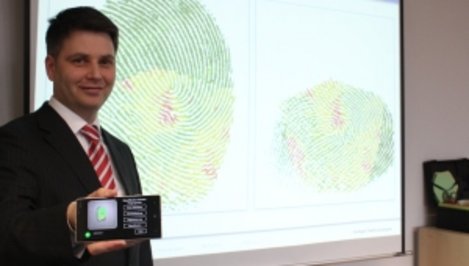Crime scene investigation with smartphones

“IT innovations from Saxony-Anhalt”
This is the CeBIT “feature” on 17 March, organised by the region at booth C06 in Hall 9. Companies from Saxony-Anhalt will be staging a clear, hands-on presentation of innovative IT solutions for medical technology, safety and data security. Exhibitors include Magdeburg-based METOP GmbH, which has developed an app for the police to image superimposed fingerprints that could not previously be analysed.
A “good” fingerprint on a weapon or a window can provide a useful lead for criminal investigators ‑ and put the suspect on the spot. Fingerprints are, however, seldom “good”. Door handles and window catches are often covered in overlapping, superimposed fingerprints, making print analysis difficult or indeed impossible. Staff at METOP GmbH in Magdeburg, a company affiliated to Otto von Guericke University, are researching how to allow superimposed fingerprints to be analysed. They have been working closely with the forensic experts who secure evidence at crime scenes, and those who analyse that evidence. The METOP team started by developing mathematical algorithms to separate out the prints, before ultimately transferring this procedure to an app enabling initial assessment at the scene of the crime.
The scientists and mathematicians at METOP are not the only researchers trying to help detectives on criminal investigations. Internationally, researchers are working on reliable ways to establish the age of fingerprints, on touchless fingerprinting methods and on how to detect the order in which prints have been made. Chemists are investigating the combined effect of sweat breakdown and ambient conditions, while the computer scientists at METOP are calculating angles and lines, direction and shapes, in order to separate out different prints. Support for the METOP team comes from Professor Frank Ortmeier and his students at the Otto von Guericke University Magdeburg Faculty of Computer Science.
Clearly distinguishing which features belong to which fingerprint is not always possible, so colour-coding is used to make the experts’ analysis job easier. If the lines of superimposed prints are close and hard to separate, print features in these areas cannot be detected. They are coloured in red ‑ not suitable for analysis. Areas that can be analysed, but are not ideal, are coloured in yellow and clearly distinguishable areas in green. “Thanks to this colour-coding, detectives using a police smartphone with this photo app should be able to reliably judge the potential usefulness of prints while still at the crime scene”, explains Professor Thomas Leich, director of the METOP Applied Computer Science division. “The useful prints found can then be recorded as evidence.”
The computer takes around ten minutes to distinguish fingerprints exactly. However, not everything can be left to the machine. “We also need the experience and discretion of an expert”, says Leich; “the human professional will see many aspects more clearly, or indeed different.” For example, the user selects the block sizes for imaging the lines to ensure that at least one line is clearly visible. “Our close cooperation with forensic professionals and print analysis experts from Saxony-Anhalt’s Office of Criminal Investigation (Landeskriminalamt Sachsen-Anhalt) was key: when the computer program and the app are finally launched, they need to be sure that this procedure will provide an accurate analysis that will stand up in court”, emphasises computer scientist Andy Kenner.
However, the app has yet to reach that stage. Researchers need nothing if not staying power ‑ they first had the idea for such a procedure back in 2008. Whilst the software and the app have now been developed, data protection issues now need to be addressed. Comprehensive testing is also required for fine tuning on the basis of expert feedback. Finally, the product must undergo extensive decision-making and approval processes before it can be launched for police use.
In other projects, the road from lab to practice is rather shorter. METOP works with both major IT corporations and small and medium-sized enterprises. The company offers process consultancy and software engineering services, and provides businesses with management and logistics support. METOP also assists on concepts for attracting young talent, and workplace design concepts for older employees. The company itself has no problems finding new young staff. “Our proximity to the university is a great advantage, we cooperate on research projects and work with many of the students ‑ that is our source of new talent”, says Professor Thomas Leich.
Visit Saxony-Anhalt at CeBIT 2015 in Hannover in Hall 9, Stand C06 or online at: www.invest-in-saxony-anhalt.com/cebit-2015 .
Company Contact:
Professor Thomas Leich
Landline: +49 391 54486 19245,
Mobile: +49 173 649 4407,
E-mail: thomas.Leich@metop.de
Internet: www.metop.de
Press Contact
Investment and Marketing Corporation Saxony-Anhalt
The economic development agency of the German Federal State Saxony-Anhalt
Tanja Ruedinger
Project Manager International Press & PR
Am Alten Theater 6
39104 Germany
Phone: +49 (0) 391 568 99 76
Fax: +49 (0) 391 568 99 51
E-Mail: tanja.ruedinger@img-sachsen-anhalt.de
